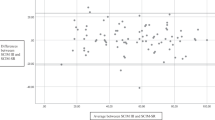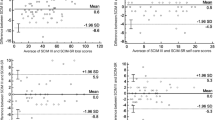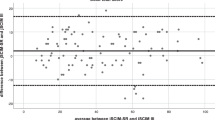Abstract
Study design
A cross-sectional psychometric study.
Objective
To translate, culturally adapt and validate the Chinese version of the Spinal Cord Independence Measure III-Self Report (SCIM-SR).
Setting
Four rehabilitation centers in Guangzhou, Chengdu, and Shiyan, China.
Methods
Translation and cultural adaptation of the Chinese version of the SCIM-SR was conducted according to Brislin guidelines. A total of 147 spinal cord injury patients self-rated their functional independence using translated instrument. The psychometric properties of content validity, criterion-related validity, internal consistency reliability, and test–retest reliability were examined.
Results
The content validity index of the new scale was 0.99. The intraclass correlation coefficient between the total SCIM-SR and SCIM III scores was 0.935, and the coefficients for its three subscales were 0.899, 0.760, and 0.942. Bland–Altman analysis showed that the mean difference between the total SCIM-SR and SCIM III scores was 2.35 (95% confidence interval −0.58 to 5.28), and differences for the three subscales were 0.75 (−0.51–2.01), 1.30 (−0.63–3.23), and 0.30 (−0.80–1.40). The Cronbach’s α coefficients for the total scale, the self-care subscale, and the mobility subscale were 0.908, 0.913, and 0.895, respectively. The α for the respiration and sphincter management subscale was 0.581. Test–retest reliability after 2 weeks yielded a Spearman coefficient for the total scale of and subscale values all above 0.73.
Conclusions
Our results indicate acceptable validity and reliability of the Chinese version of SCIM-SR. It may facilitate long-term evaluations of independence in Chinese spinal cord injury patients in the community and at home.
Similar content being viewed by others
Log in or create a free account to read this content
Gain free access to this article, as well as selected content from this journal and more on nature.com
or
References
Aguilar-Rodríguez M, Peña-Pachés L, Grao-Castellote C, Torralba-Collados F, Hervás-Marín D, Giner-Pascual M. Adaptation and validation of the Spanish self-report version of the Spinal Cord Independence Measure (SCIM III). Spinal Cord. 2015;53:451–4.
Al Huthaifi F, Krzak J, Hanke T, Vogel LC. Predictors of functional outcomes in adults with traumatic spinal cord injury following inpatient rehabilitation: a systematic review. J Spinal Cord Med. 2017;40:282–94.
Furlan JC, Noonan V, Singh A, Fehlings MG. Assessment of disability in patients with acute traumatic spinal cord injury: a systematic review of the literature. J Neurotrauma. 2011;28:1413–30.
Catz A, Itzkovich M, Agranov E, Ring H, Tamir A. SCIM—spinal cord independence measure: a new disability scale for patients with spinal cord lesions. Spinal Cord. 1997;35:850–6.
Catz A, Itzkovich M, Tamir A, Philo O, Steinberg F, Ring H, et al. SCIM—spinal cord independence measure (version II): Sensitivity to functional changes. Harefuah. 2002;141:1025–31.
Catz A, Itzkovich M, Tesio L, Biering-Sorensen F, Weeks C, Laramee MT, et al. A multicenter international study on the Spinal Cord Independence Measure, version III: Rasch psychometric validation. Spinal Cord. 2007;45:275–91.
Riberto M, Tavares DA, Rimoli JRJ, Castineira CP, Dias RV, Franzoi AC, et al. Validation of the Brazilian version of the Spinal Cord Independence Measure III. Arq Neuropsiquiat. 2014;72:439–44.
Saberi H, Vosoughi F, Derakhshanrad N, Yekaninejad M, Khan ZH, Kohan AH, et al. Development of Persian version of the Spinal Cord Independence Measure III assessed by interview: a psychometric study. Spinal Cord. 2018;56:980–6.
Anderson KD, Acuff ME, Arp BG, Backus D, Chun S, Fisher K, et al. United States (US) multi-center study to assess the validity and reliability of the Spinal Cord Independence Measure (SCIM III). Spinal Cord. 2011;49:880–5.
Scivoletto G, Tamburella F, Laurenza L, Molinari M. The spinal cord independence measure: how much change is clinically significant for spinal cord injury subjects. Disabil Rehabil. 2013;35:1808–13.
Fekete C, Eriks-Hoogland I, Baumberger M, Catz A, Itzkovich M, Lüthi H, et al. Development and validation of a self-report version of the Spinal Cord Independence Measure (SCIM III). Spinal Cord. 2013;51:40–7.
Bonavita J, Torre M, China S, Bressi F, Bonatti E, Capirossi R, et al. Validation of the Italian version of the Spinal Cord Independence Measure (SCIM III) self-report. Spinal Cord. 2016;54:553–60.
Liu N, Xing H, Zhou M, Biering-Sørensen F. Lack of knowledge and training are the major obstacles in application of the Spinal Cord Independence Measure (SCIM) in China. J Spinal Cord Med. 2019;42:437–43.
Berardi A, Biondillo A, Màrquez MA, Santis RD, Fabbrini G, Tofani M, et al. Validation of the short version of the Van Lieshout test in an Italian population with cervical spinal cord injuries: a cross-sectional study. Spinal Cord. 2019;57:339–45.
Brislin RW. Back-translation for cross-cultural research. J Cross Cult Psychol. 1970;1:185–216.
Ye C, Sun T, Liu Z, Wang C, Zhang J, Fan C, et al. The validity and reliability of Chinese version of spinal cord independence measure III. Chin J Rehab Med. 2012;06:529–32.
Shi J, Mo X, Sun Z. Content validity index in scale development. J Cent South Uni Med Sci. 2012;37:152–5.
Whitley E, Ball J. Statistics review 6: nonparametric methods. Crit Care. 2002;6:509–13.
Bland JM, Altman DG. Statistical methods for assessing agreement between two methods of clinical measurement. Lancet. 1986;1:307–10.
Kuo BI. Intraclass correlation coefficient rather than correlation coefficient to examine agreements among different methods measuring valvular area. Circulation. 1994;89:1910–1.
Cronbach L. Coefficient alpha and the internal structure of tests. Psychomerika. 1951;16:297–334.
Schober P, Boer C, Schwarte LA. Correlation coefficients: appropriate use and interpretation. Anesth Analg. 2018;126:1763–8.
Wilartratsami S, Luksanapruksa P, Santipas B, Thanasomboonpan N, Kulprasutdilok P, Chavasiri S, et al. Cross-cultural adaptation and psychometric testing of the Thai version of the Spinal Cord Independence Measure III-self report. Spinal Cord. 2020; https://doi.org/10.1038/s41393-020-00556-7.
Tavakol M, Dennick R. Making sense of Cronbach’s alpha. Int J Med Educ. 2011;27:53–55.
Acknowledgements
The authors would like to thank the 4 rehab centers: Sichuan Provincial Rehabilitation Hospital in Chengdu; Guangdong Provincial Work Injury Rehabilitation Hospital in Guangzhou; Sun Yat-sen Memorial Hospital at Sun Yat-sen University in Guangzhou; and the Taihe Hospital in Shiyan. Special thanks to Min Zhang who provided statistical analysis support.
Funding
The study was supported by China’s National Natural Science Foundation (grant 71603293). The sponsor had no role in the study’s design, in the collection, analysis, or interpretation of data, in writing the report or in the decision to submit this article for publication.
Author information
Authors and Affiliations
Contributions
TW drafted and revised the manuscript. JT was responsible for the statistical analysis and reviewed the manuscript. JT, SX, XH, and YW participated in the study’s implementation. TL and MJ were responsible for the translation work and data collection. KL was responsible for the project’s design and implementation, quality control, and manuscript revision.
Corresponding author
Ethics declarations
Conflict of interest
The authors declare that they have no conflict of interest.
Statement of Ethics
The study was approved by the ethics committees of the university and the participating rehabilitation centers (2017ZSLYEC-0620). We certify that all applicable institutional and government regulations concerning the ethical use of human volunteers were followed during the course of this research. The translation of the scale was authorized by the original author of the SCIM-SR.
Additional information
Publisher’s note Springer Nature remains neutral with regard to jurisdictional claims in published maps and institutional affiliations.
Supplementary information
Rights and permissions
About this article
Cite this article
Wang, T., Tang, J., Xie, S. et al. Translation and validation of the Chinese version of the Spinal Cord Independence Measure (SCIM III) Self-Report. Spinal Cord 59, 1045–1052 (2021). https://doi.org/10.1038/s41393-020-00601-5
Received:
Revised:
Accepted:
Published:
Issue date:
DOI: https://doi.org/10.1038/s41393-020-00601-5
This article is cited by
-
Validity and reliability of the Turkish version of the Spinal Cord Independence Measure (SCIM III) self-report
Spinal Cord (2025)
-
A national cross-sectional survey on community spinal cord injury individuals profiles, health-related quality of life and support services in China: implications for healthcare and rehabilitation
BMC Musculoskeletal Disorders (2024)
-
Validation of the Nepali version of the Spinal Cord Independence Measure Self-Report
Spinal Cord Series and Cases (2024)
-
Adaptation and validation of the Japanese version of the Spinal Cord Independence Measure (SCIM III) self-report
Spinal Cord (2021)



